Probably one of the latest hot marketing terms to see rampant use in the indie scene is "roguelike," regardless of whether it really suits the game in question.
No, I don't plan to tackle that can of worms (the topic gets more than enough attention over on /r/roguelikes), but I would like to begin a series of posts aimed at clarifying "what makes Cogmind a roguelike," and, more importantly, what perhaps unexpected features it adds to the mix.
We'll start with the basics, those features which most players familiar with the genre have come to expect.
Procedural Generation
This is the element that has apparently become synonymous with "roguelike," which is completely wrong--granted it's an absolutely required core feature of roguelikes, but the genre is defined by so much more than PCG (procedural content generation).
For each new game Cogmind generates the world layout, individual maps, and procedurally* distributes what content you might encounter. *Note that "procedural" is not "random"--the process is driven by data and algorithms with a purpose.
However, overuse or misuse of PCG risks leading to a bland experience, thus most roguelikes don't go so far as full procedural generation of enemies, items, etc. Neither does Cogmind. Players and the world itself can both benefit from a certain amount of static content to latch onto. In Cogmind we could easily generate robots from an assortment of parts (considering we have so many), but there's a lot of value in keeping robots (and parts) hand-crafted as they are. Static content has two advantages, enabling 1) us to build the game's lore around specific dependable content and 2) players to form a strategy around known factors in an otherwise ever-changing world.
In this area Cogmind is therefore pretty much what you expect from a roguelike: maps are generated, most everything else is defined beforehand and referenced by the generator when putting those maps together. The approach is sufficient to provide infinite replayability without putting too great a burden on the player to relearn everything with each new play.
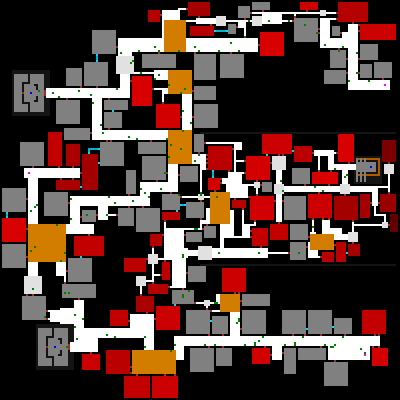
Cogmind's map generator building factory map layouts for a 200x200 space from
a combination of algorithms and a few hand-made prefab pieces.
Permadeath
Another roguelike staple, permadeath goes hand-in-hand with procedural generation. In case you didn't know, permadeath means no loading saved games aside from continuing your most recent game, and loss is permanent (unless you're cheating!=p). It would be quite boring if a game forced you to restart from the beginning on failure without offering a new experience each time, hence the advantage of procedural maps here.
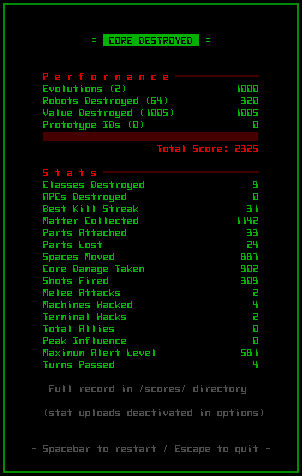
You'll be seeing a lot of this until you get the hang of it.
(One of the performance indicators is obscured as it's a minor spoiler.
Also, the factors that contribute to your final score will likely be changing.)
Cogmind is actually more forgiving than many traditional roguelikes. In most roguelikes if you stand motionless and unresponsive next to an enemy, you'll probably be dead in mere turns.
Not so with Cogmind. While I wouldn't recommend letting enemies wail on you, the mechanics are such that sudden death is impossible. Even quick death is unlikely unless you're intentionally avoiding the most basic defensive measures (or you're exploring optional dangerous areas in the late-game).
You are pretty resilient and most likely to die from poor planning/decision-making, or attrition (this works because there is no normal way to heal/repair damage beyond reaching new areas!). The pre-alpha is currently not balanced enough to promise you won't run into some very deadly situations, but the final goal is a fair game in which you can win a majority of runs once you've accumulated enough meta experience.
Despite the long-term attrition approach to success or failure, rarely are you forced into a "walking dead" scenario wherein you're pretty much guaranteed to lose the game but just haven't died yet.
For the experienced player, comebacks are commonplace. You can be reduced to a barely functioning mobile pile of scrap, only to several hundred turns later once again be an armored four-legged menace bristling with cannons (or maybe you decided to keep a low profile and stole some flight units and sensor gear instead).
And even for the new player, there's always the opportunity to simply absorb the damage from attacks while fleeing (or even outrun pursuers) until you happen across an exit, which might be just around the next corner.
In short, there is always hope! On reaching a new area you'll (usually) be safe from attack for a bit, giving you a chance to build up if necessary.
Turn-Based
This is a somewhat controversial factor of roguelikeness, more so in modern times where there's a high degree of genre mixing going on in the indie segment. Roguelike gameplay traditionally takes place in both discrete time and space (the two are fairly complementary). Certainly all the classic roguelikes fall under this category.
Roguelikes are a test of problem solving skills rather than reflexes, thus we should have as much time as necessary to consider options and make decide on a course of action. Sure we're all guilty of the "pressed the key too many times and died" experience, but we did have the opportunity to stop and think if we hadn't gotten so complacent at the wrong time!
This puts pausable real-time games like FTL into a gray area I won't address here, but I do think non-pausable real-time games, while they can certainly embrace the roguelike spirit, really belong to a different category ("roguelites") because they test decision-making from a different angle by putting an emphasis on physical coordination.
Anyway, Cogmind is turn-based and grid-based, the latter part so ingrained in the UI that even the map tileset doesn't use connected wall segments.
Regarding the turn-based mechanics, for those who haven't played the prototype I should briefly introduce how it works. Cogmind uses a "time-energy" system as seen in a number of other roguelikes: Each game turn gives every actor (robot) 100 units of time, and performing an action reduces the available time by the cost (duration) of that action. Whichever robot has the greatest available "time" is the next to act. So performing actions with a greater time requirement will allow other robots to perform more actions before you can act again (unless they, too, perform time-consuming actions).
All of this happens under the hood, though you'll get a feel for it as you play, plus some of the numbers are shown to you where important to help make comparisons and weigh decisions.
Most actions take about 100 time units, i.e. can be carried out once per turn. There are primarily two other actions that can vary greatly in how much time they require: movement and shooting.
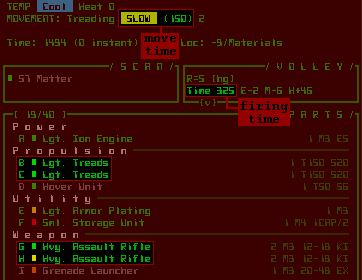
Current speed in "time to move one space" as shown in the HUD.
Also the amount of time required to fire the currently active volley of weapons.
One significant difference between Cogmind's design and the average "time-energy" system (or other similar system) is that in other games the time differences between actions are intentionally fairly subtle, or at least don't exceed a certain reasonable threshold. By comparison it's possible in Cogmind to have extremely exaggerated time costs, so be careful of that! This would be a result of your own design, something you have to aim to balance while maintaining peak efficiency for the functionality you want.
In a worst case scenario assuming you're a massive hulk of parts hopping along on one leg, you could move a single space and suddenly everyone within sight gets 2-3 shots at you, and again for every further step you take (in this case, if your goal is to escape, you may be forced to drop your stuff and run; or pull out that grenade launcher you've been hoarding and make a stand!).
The opposite is also true: you could fly so fast that enemies don't even see you as you zip down the corridor and off into another room.
As you can see your speed value is incredibly important to how things play out.
Firing weapons can have a similarly exaggerated effect on relative time since you're allowed to fire as many weapons as you want, but the total firing time could span multiple turns during which other robots can continue to act.
This makes large attacks front-loaded (since you are in effect spending a block of future time that you don't have--time energy can be negative), but dangerous if used improperly. The benefit to larger volleys is that each additional weapon requires less additional time to fire, until it's almost insignificant (because the more firing, the more that are able to do so simultaneously).
There is a lot of tactical decision-making involved in how many of what type of weapon to fire at what kind of target, but that will be for you to explore.
Combat
Ah, bumping into something until you kill it, the time-honored simplest method of conflict resolution in roguelikes.
It's true that roguelikes don't have to be combat-oriented, but aside from fun 7DRL experiments we see that the most popular roguelikes are all about causing death and destruction.
For all its guns, cannons, and missile launchers, Cogmind is actually kind of an anti-combat game. Unlike in other roguelikes, combat is not a way to improve yourself. Sure you can "re-appropriate" parts scrapped from a robot, but there are also plenty found elsewhere for the taking (and what you find elsewhere is better, no less).
This has the advantage of making the stealth approach a much more meaningful strategy, which the game has plenty of mechanics to support. You aren't required to fight anything at all. That said, it's likely that even the stealthiest Cogmind, and most players aiming to win (as opposed to just causing mayhem, which is lots of fun, too), will end up fighting the occasional battle in the interest of avoiding greater confrontations that are even more difficult to evade or control. (For example, if you encounter a lone patrol squad that might spot you and warn others, you have the choice to lure them to a suitable battleground and take them out, or take a detour and risk it.)
Most roguelikes are heavy on combat, and while the genre is now trending towards more interesting forms of interaction than bump-them-til-they-die, melee attacks remain a staple action. They take a back seat in Cogmind.
In fact, Cogmind's original prototype had no melee weapons at all--they have since been added as a new option you probably won't solely rely on, but that do come in handy in certain situations.
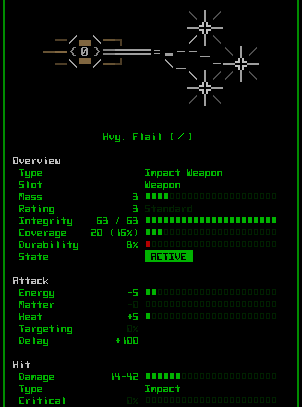
Handy indeed...
The vast majority of combat in Cogmind takes place at range, which changes the experience significantly. This is not you one-sidedly mowing down waves of short-range attackers approaching from a distance; encounters are all-out firefights in which almost every enemy you meet can pound you from range.
Not only that, but you can fire as many weapons as you can attach and power at once, none of those left hand, right hand limits :)

About to let loose (poor strategy--one grenade or rocket at a time would be enough for these guys). I made this into a gif so you could see the scene in both ASCII and tiles.
Inventory Management
Interaction is a key gameplay element in roguelikes. While items (and usually by extension an inventory) are by no means required for a roguelike, they do offer a useful medium for expanding the number of possible interactions.
I've already covered Cogmind's unique inventory system and its impact on gameplay in great detail in a separate post.
ASCII & Tiles
While I don't believe ASCII is an essential feature of roguelikes, it does embody the ideal roguelike interface: a simple easily readable representation designed to facilitate decision-making. For my take on the inherent benefits of ASCII as opposed to tiles, see this earlier post. No sense in rehashing that discussion here.
Most popular roguelikes these days offer both modes, and so does Cogmind. The use of ASCII is pretty well represented and documented throughout the blog and game website; the tileset and an analysis of its composition can be seen/read here.
What most roguelikes don't have is ASCII art. Drawing it all was a huge amount of work (one reason most RLs avoid it...), but in Cogmind every item has associated art that adds a lot of character (or "characters" depending on how you look at it =p).
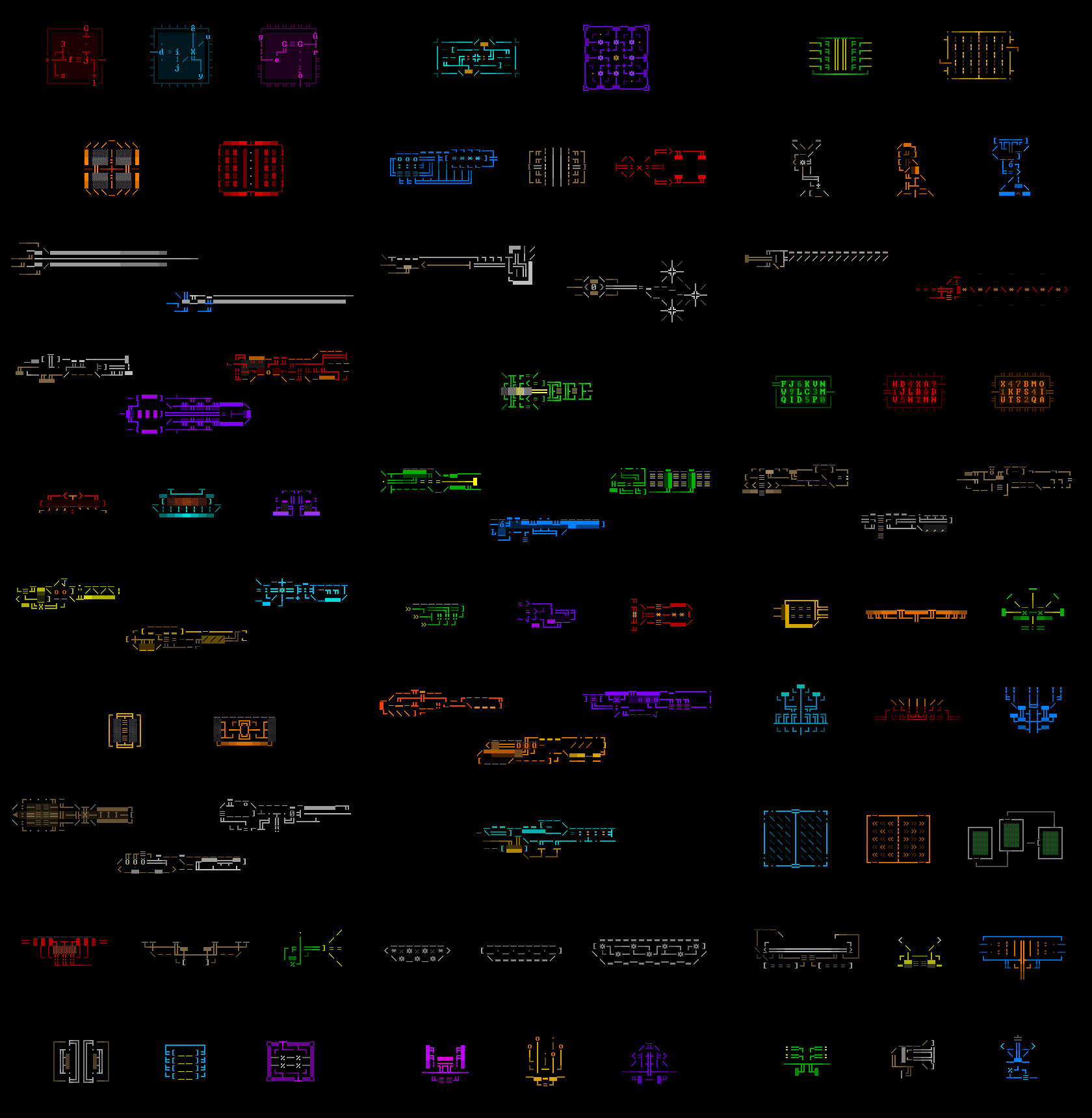
Compilation of ASCII art samples (click for full size, or check out the introduction to all these item categories in the Cogmind ASCII Art Gallery).
Cogmind's ASCII particle effects are also a big draw seen elsewhere only in moderation, not least of all because they can cause a bit of a pacing issue with what are normally quick to play games. The negatives are mitigated by tying animation speed to the importance of the attack--weak weapons animate extremely quickly while big powerful weapons and explosions can afford a little extra time for their animation (like maybe 300-1500 milliseconds compared to 100-200ms).
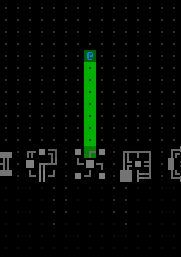
If I'm going to put the effort into making something blow up, may as well as give it some juicy particle goodness. (Composite image showing explosion reversal and switch to tiles mode for fun.)
Accessibility
Roguelikes are traditionally not very accessible. [/understatement]
However, modern roguelikes are trending towards broader accessibility, what with standard 2D visuals (no ASCII, even?!), proper mouse support, and other features mainstream audiences expect from a modern game. This is great for attracting new players to the genre, something we need in order to create bigger better roguelikes, while also aiding discoverability of those that already exist.
What I've done with Cogmind is apply most of these same modern UX design principles to a traditional ASCII interface, which surprisingly very few developers bother to do. And why not? We get to keep our minimalist ASCII and at the same time make the game accessible to players who won't, for example, memorize 100 keyboard commands.
Simply put, Cogmind's design adheres to a handful of guidelines that go a long way towards accommodating different types of players.
First and foremost, every action and command must be accessible via both mouse and keyboard. Sometimes there are even multiple keyboard commands for the same action (four different sets of movement commands are supported).
Furthermore, alphanumeric keyboard commands are embedded directly into the UI wherever they make sense and can look good, facilitating learning of hotkeys.
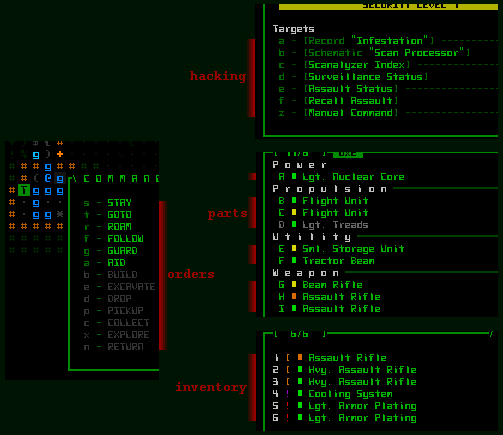
Embedded keyboard commands appear all over the place, and fit nicely with the style of the interface.
Here I must regretfully announce one of Cogmind's only major failings in this area: there are no keyboard rebinds! It's theoretically possible, but given the state of the program architecture would be a rather large project in itself. Everything is arranged on the keyboard as logically as possible, though this doesn't help players with non-US keyboards. We'll see what kind of issues we encounter once the game is released, but there's always mouse input, or a mouse-keyboard hybrid, as alternatives.
And we'll see if we can get any of the really fringe players on board with drag-and-drop inventory manipulation! :)
Cogmind doesn't yet have any explicit support for color blind players, though some solutions could be implemented based on needs as described in an earlier post.
One design feature that will hopefully mitigate the need for alternative color blind solutions, while at the same time improving the general player experience, is multi-channel feedback.
Wherever possible, Cogmind presents the same information through multiple means, usually a combination of colored words, symbols, sound effects, and animation.
For example, when you are low on core integrity (health) a warning sound plays, a red "ALERT" text box appears next to integrity on the HUD, and all the interface window frames oscillate between their normal green color and red. It's unlikely you'll miss the news.
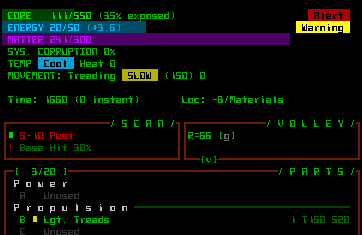
Plenty of indicators and alarms warn you when things aren't going so well.
An example of multiple ways to obtain the same information: The name of an enemy robot is automatically shown when you first see it, and can also be found by hovering the cursor over it (to show its name, whether it's spotted you and other info in the HUD scan info area), pressing '1' to label all robots, holding ctrl-shift and hovering the cursor to label that one robot, right-clicking on the robot to open its full data page, or pressing 'x' (look mode) then 'tab' to automatically shift the cursor to the enemy and label it (from where you can press 'd' for data to open its info if you want to know more than the scan window shows).

Calling up a label for a nearby robot, basic data for which is also shown in the HUD scan window: red name for hostile, green rectangle for its current core integrity, red exclamation mark meaning it's spotted you, and the base chance to hit it. (Same scene shown in both ASCII and tiles.)
Text-heavy games like roguelikes place a lot of importance on fonts, and with good reason because there's a lot of reading to do. I've mentioned before that Cogmind's design attempts to shift as much information as possible from the message log to the map itself, but you'll still be reading plenty of words, phrases, and short sentences.
The earliest roguelikes, true terminal RLs, had no choice but to stick to a single font, but with more and more of today's roguelikes making use of emulated terminals, we have more options and should use them to lighten the burden on the player. (For an in-depth discussion and lots of images from other roguelikes, see this post.) Wide/square fonts are difficult for reading text, while narrow/rectangular fonts create distorted maps. So why not use a mix of both? Naturally plenty of modern roguelikes that have moved away from the traditional grid-based environment already do this, but we can technically apply it to the grid as well.
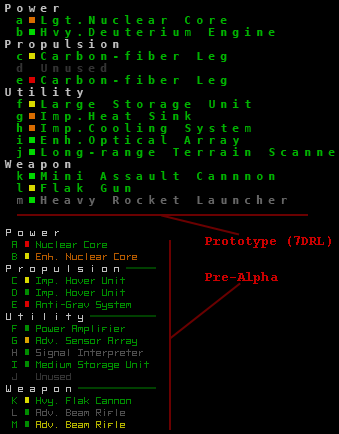
For the 7DRL/prototype Cogmind chose to emphasize a square cell size for maps, which unfortunately meant that text like the list of parts was not very pleasant to read--this has been vastly improved by enabling mixed font dimensions in the current version.
Improved readability of the respective interface areas is Cogmind's biggest single visual change from the 7DRL prototype, and something that sets it apart from almost every other ASCII roguelike. With multiple fonts we can get the best of both worlds. (More about Cogmind's font design here.)
Audio feedback is an element of accessibility, but also contributes to the game's environment, so it gets its own section:
Audio
One could say this feature is somewhat controversial with regard to roguelikes, because it is known that many traditional roguelike players will play a game silently or to alternative music/audio, even when the game provides its own. Certainly players we may be able to attract from adjacent genres are used to and interested in relying on a game's own audio, and I think there is much room in traditional roguelikes for the suitable application of sound effects.
Audio feedback is to me one of Cogmind's biggest leaps forward as far as roguelike evolution is concerned. Not many traditional roguelikes take advantage of the potential benefits of a robust sound system, and none do it to the same extent Cogmind does. I've already written an entire series of posts on the usage and development of sound effects in roguelikes and Cogmind.
While I wouldn't say audio is absolutely necessary to play, it is without a doubt a huge part of both the experience and the accessibility of the interface. The interface is relatively dense and there can be a lot going on, making it sometimes difficult to notice everything of importance. Thus for every visual effect there is an accompanying sound (yes, that's quite a lot of sounds), making it more likely you'll be aware of important events and changes.
In its final state Cogmind will include even ambient sound effects to further develop the atmosphere, as described before. The goal there, as with map-wide ambient music/sound, will be to implement them in a manner that doesn't interfere with the existing sound system's accessibility-enabling qualities.
More than a Dungeon
The average roguelike dungeon-diving experience can be describes as a single player exploring corridors and rooms in which lurk individual or groups of unrelated monsters or humanoids. You aren't expected to question why that dragon didn't eat those orcs last time it got hungry.
Roguelikes with themed dungeon areas get around this oddity by at least limiting the local population to a variety of similar or related creatures, though rarely do we see any kind of larger ecosystem (the recently revived Incursion is a notable exception). This form does have its merits, successfully condensing as much interesting and unique material into as small a space as possible and thereby increasing the number of unexpected emergent situations to focus on the tactical decision-making aspect so central to roguelikes.
In this area Cogmind makes a rather large departure from most roguelikes with one of its more exciting aspects that I've been holding off discussing in any detail: A dynamic world with an overarching AI.
One reason for delaying its introduction was that it's a final stage of pre-alpha development that has only taken shape in recent months, and of course even in introducing this feature I can only say so much without spoiling the game by revealing how it works.
In short, all robots have some purpose other than just attack the player (and many robots don't/can't attack at all), while many areas of the game are overseen by a larger AI that controls the population, a population which is at the same time capable of communicating within its own ranks.
This is actually a huge topic to be discussed in two separate upcoming posts, one about the world layout and traversing it, and another about the inhabitants of that world. Stay tuned for those.
Conclusion
The "list of features" approach is not always a valid way to identify "roguelikes," a label that some players afford to games simply based on the gestalt experience offered by the totality of their moving parts. It is nonetheless a useful way to discuss this timeless argument. I mean topic.
Few will claim that Cogmind is not a roguelike, but at the same time there are many elements that set it apart from traditional roguelikes in both form and substance. I hope that it will appeal to both long-time players and those new to the genre. A truly modern roguelike. Rock, Paper, Shotgun really picked up on that when they named Cogmind one of the best upcoming PC games of 2015, writing "Cogmind is an impressive merging of old and new school game design." :D



amazing, perfect titles mod
Glad you like it! Our artist is going crazy trying to scale the tiles to all supported resolutions, but he's doing a wonderful job of it :)
Will game have easter eggs? : )
Oh please! this would be awesome. Throw backs to classic games and new ones! RL and non :o
I do have an idea for one true easter egg referring to the main game from which Cogmind draws inspiration (not telling, though you may have heard me mention it before). Others will be contingent on me being able to think of appropriate related content, but are somewhat limited due to asset requirements (art, sfx).
Well, there will be rare content that is difficult to find (a small amount of which has already been added), though as of yet none which breaks the immersion--it usually plays along with the theme somehow. I do have a few ideas for true easter eggs I'd like to add. Still, there won't be as many as there would be if we were pure ASCII, because tiles mode requires additional assets which are more time consuming (and costly) to add.
Support from Portugal, already told around to 7 friends who are crazy for RL. This is a masterpiece waiting to be unleashed to the world, and I am sure it will allow you guys to move to bigger projects in the future.
Keep up the good work!
Many thanks, and I hope so! As long as it's reasonably successful there will definitely be more down the road.
Keep spreading the word :D
This project alone will have required nearly three years by the time it's completed, after which the next might be a slightly quicker project, followed by a huge one into which I've already poured two years of work but with plenty more to go.
Simply outstanding. Can't wait for release. Keep up the good work.
Thanks, hard at work over here to make it happen :D